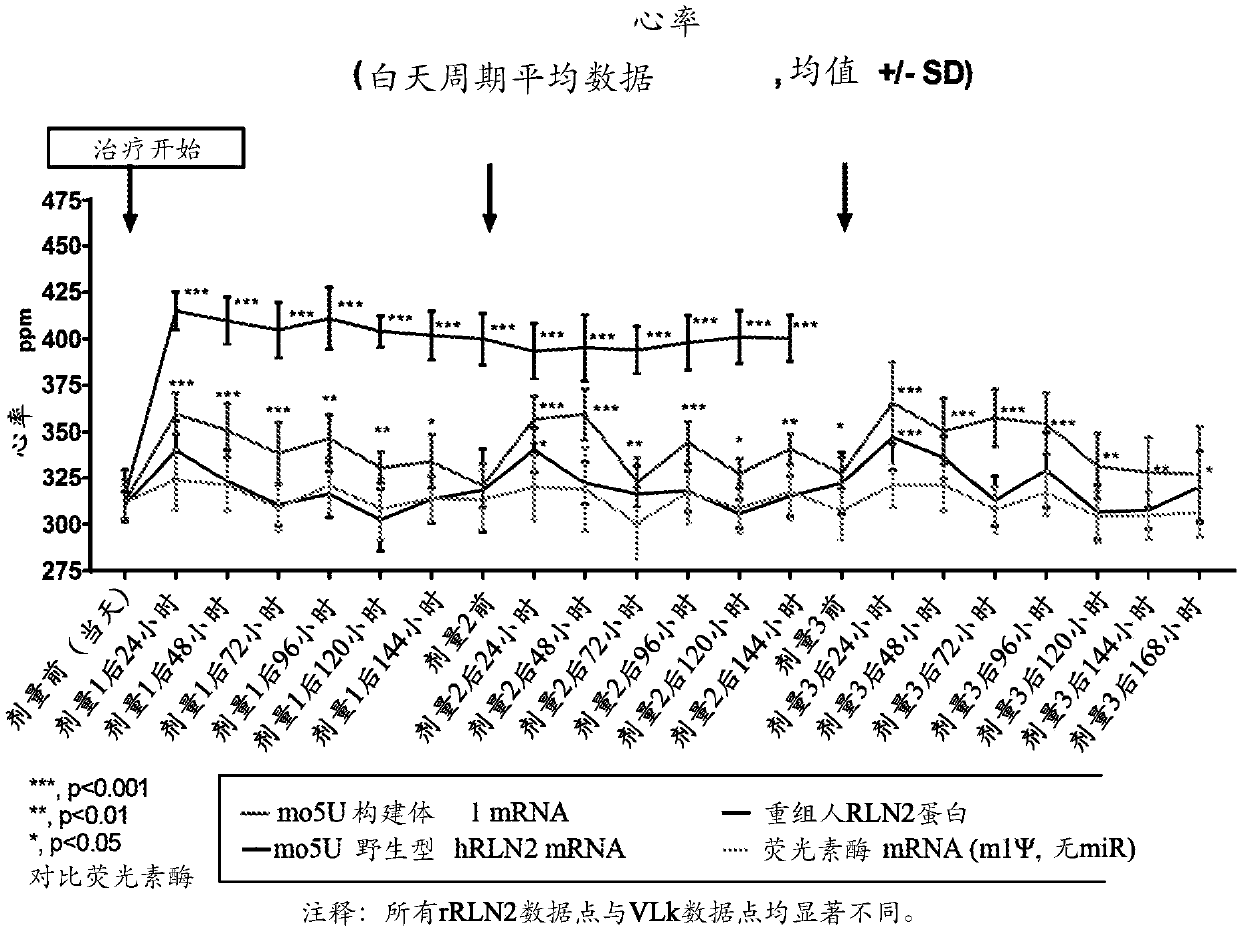Polynucleotides encoding relaxin
A polynucleotide and relaxin technology, applied in the field of polynucleotides encoding relaxin, can solve problems such as efficacy problems
- Summary
- Abstract
- Description
- Claims
- Application Information
AI Technical Summary
Problems solved by technology
Method used
Image
Examples
example 1
[1681] Example 1: Manufacture of Polynucleotides
[1682] According to the present disclosure, the manufacture of polynucleotides and parts or regions thereof can be accomplished using the methods taught in International Application WO2014 / 152027 entitled "Manufacturing Methods for Production of RNA Transcripts", The contents thereof are incorporated herein by reference in their entirety.
[1683] Purification methods may include those taught in International Applications WO2014 / 152030 and WO2014 / 152031, each of which is incorporated herein by reference in its entirety.
[1684] Methods of detection and characterization of these polynucleotides can be performed as taught in WO2014 / 144039, which is hereby incorporated by reference in its entirety.
[1685] Characterization of polynucleotides of the present disclosure can be accomplished using a program selected from the group consisting of polynucleotide mapping, reverse transcriptase sequencing, charge distribution analysis...
example 2
[1686] Example 2: Chimeric polynucleotide synthesis
[1687] introduce
[1688] According to the present disclosure, two regions or portions of a chimeric polynucleotide can be joined or linked using triphosphate chemistry.
[1689] According to this method, a first region or portion of 100 nucleotides or less is chemically synthesized with a 5' monophosphate and a terminal 3' deOH or block OH. If the region is longer than 80 nucleotides, it can be synthesized as two strands for ligation.
[1690] If the first region or portion is synthesized as a non-positionally modified region or portion using in vitro transcription (IVT), then the 5' monophosphate can be subsequently converted and the 3' end capped.
[1691] Monophosphate protecting groups may be selected from any of those known in the art.
[1692] The second region or portion of the chimeric polynucleotide can be synthesized using chemical synthesis or IVT methods. IVT methods can include RNA polymerases that can...
example 3
[1705] Example 3: PCR for cDNA Production
[1706] 2x KAPA HIFI using Kapa BioSystems (Woburn, MA) TM HotStart ReadyMix for PCR procedures for cDNA preparation. This system includes 2x KAPA ReadyMix 12.5μl; forward primer (10μm) 0.75μl; reverse primer (10μm) 0.75μl; template cDNA-100ng; 2 0, diluted to 25.0 μl. Reaction conditions were 95°C for 5 minutes, and 25 cycles of 98°C for 20 seconds, then 58°C for 15 seconds, then 72°C for 45 seconds, then 72°C for 5 minutes, then 4°C to stop.
[1707] Using PURELINK from Invitrogen TM The PCR Micro Kit (Carlsbad, CA) was used to clean up reactions (up to 5 μg) according to the manufacturer's instructions. Larger reactions will require cleaning with a higher capacity product. After cleaning, use NANODROP TM Quantify the cDNA and analyze by agarose gel electrophoresis to confirm that the cDNA is the expected size. The cDNA is then submitted for sequencing analysis, followed by an in vitro transcription reaction.
PUM
| Property | Measurement | Unit |
|---|---|---|
| diameter | aaaaa | aaaaa |
| diameter | aaaaa | aaaaa |
| diameter | aaaaa | aaaaa |
Abstract
Description
Claims
Application Information
 Login to View More
Login to View More - R&D Engineer
- R&D Manager
- IP Professional
- Industry Leading Data Capabilities
- Powerful AI technology
- Patent DNA Extraction
Browse by: Latest US Patents, China's latest patents, Technical Efficacy Thesaurus, Application Domain, Technology Topic, Popular Technical Reports.
© 2024 PatSnap. All rights reserved.Legal|Privacy policy|Modern Slavery Act Transparency Statement|Sitemap|About US| Contact US: help@patsnap.com










